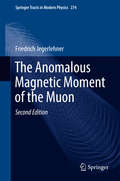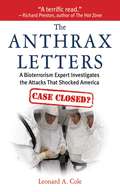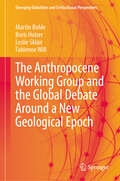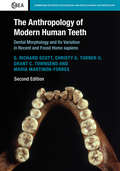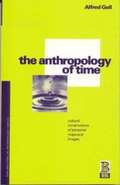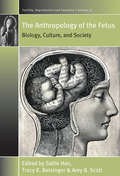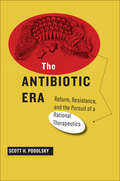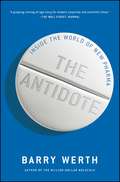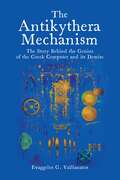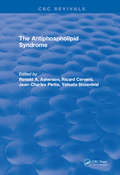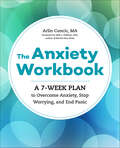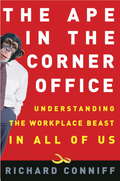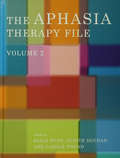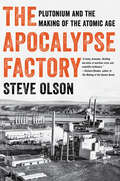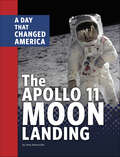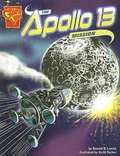- Table View
- List View
The Anomalous Magnetic Moment of the Muon
by Friedrich JegerlehnerThis book reviews the present state of knowledge of the anomalous magnetic moment a=(g-2)/2 of the muon. The muon anomalous magnetic moment is one of the most precisely measured quantities in elementary particle physics and provides one of the most stringent tests of relativistic quantum field theory as a fundamental theoretical framework. It allows for an extremely precise check of the standard model of elementary particles and of its limitations.
The Anthrax Letters: A Bioterrorism Expert Investigates the Attack That Shocked America
by Leonard A. ColeAt 2:00am on October 2, 2001, Robert Stevens entered a hospital emergency room. Feverish, nauseated, and barely conscious, no one knew what was making him sick. Three days later he was dead. Stevens was the first fatal victim of bioterrorism in America. Bioterrorism expert Leonard Cole has written the definitive account of the Anthrax attacks. Cole is the only person outside law enforcement to have interviewed every one of the surviving inhalation-anthrax victims, along with the relatives, friends, and associates of those who died, as well as the public health officials, scientists, researchers, hospital workers, and treating physicians. Fast paced and riveting, this minute-by-minute chronicle of the anthrax attacks recounts more than a history of recent current events, it uncovers the untold and perhaps even more important story of how scientists, doctors, and researchers perform life-saving work under intense pressure and public scrutiny. Updated with new information about Ivins and a series of upcoming Congressional hearings into the FBI's conduct in this case, The Anthrax Letters amply demonstrates how vulnerable America was in 2001 and whether we are better prepared now for a bioterror attack.
The Anthropocene Working Group and the Global Debate Around a New Geological Epoch (Emerging Globalities and Civilizational Perspectives)
by Boris Holzer Martin Bohle Leslie Sklair Fabienne WillThis book examines the role of the Anthropocene Working Group (AWG) in public and scholarly discussions of the meaning of the Anthropocene proposal. The status of the Anthropocene, both as a geoscientific concept and as a cultural concept becoming increasingly familiar in the public sphere, has been highly controversial. While geoscientists focus on possible geological markers and periodisation, the social sciences, environmental humanities, and creative arts have taken up the Anthropocene as a cultural concept to make sense of the planetary environmental crisis and contemporary society. This book documents intra-, inter-, and transdisciplinary debates, particularly, although not limited to, how different scholarly disciplines have responded to the Anthropocene proposal. The authors analyse how the AWG has become the focal point of a debate that straddles the boundaries between academic disciplines and public perceptions of science. The AWG thus serves as a case of the globalisation of science in terms of the global interconnectedness of scientific disciplines and the cultural significance of the Anthropocene proposal.
The Anthropocene and its Future: The Challenges of Accelerating Social and Ecological Change
by Karl BruckmeierThis book analyses the complex social and ecological processes of the Great Acceleration, the Great Transformation, and sustainable development that shape the future of the global society in the twenty-first century. The first process takes place for a longer time, the second over the past thirty years, with attempts to build a sustainable economy and society in the global policy of sustainable development. The processes and their interaction will be discussed with knowledge from inter- and transdisciplinary transformation research, social and political ecology, and theories of modern society. The guiding theoretical concepts for the social-ecological transformation will be clarified: the concepts of acceleration, transformation, and sustainable development, and the societal and ecological processes they include. To obtain a more detailed picture of the changes in the global social-ecological system, different parts of the global transformation, the digital transformation, the transformation of food systems, and the transformation of modes of living in the social lifeworld are described to show the complex changes in the epoch of the Anthropocene more concretely. The global change processes in society and nature are caused by human forces but are difficult to control through policy and governance. With the interdisciplinary integration of concepts and knowledge, it becomes possible to provide a more detailed picture, of the difficulties to achieve a sustainable future society.
The Anthropocene and the Humanities: From Climate Change to a New Age of Sustainability (The Future Series)
by Carolyn MerchantA wide-ranging and original introduction to the Anthropocene that offers fresh, theoretical insights bridging the sciences and the humanities From noted environmental historian Carolyn Merchant, this book focuses on the original concept of the Anthropocene first proposed by Paul Crutzen and Eugene Stoermer in their foundational 2000 paper. It undertakes a broad investigation into the ways in which science, technology, and the humanities can create a new and compelling awareness of human impacts on the environment. Using history, art, literature, religion, philosophy, ethics, and justice as the focal points, Merchant traces key figures and developments in the humanities throughout the Anthropocene era and explores how these disciplines might influence sustainability in the next century. Wide-ranging and accessible, this book from an eminent scholar in environmental history and philosophy argues for replacing the Age of the Anthropocene with a new Age of Sustainability.
The Anthropocene, Ontopolitics, and International Relations
by Matthew RobsonThis book addresses the ongoing need to explore the implications of the &‘Anthropocene&’ rupture for the field of International Relations (IR). Bringing together a group of established and early career academics, the chapters present a range of different ways of framing our current ecological and historical context, showing how they can be used to pursue new research directions and insights in areas of study such as governance, security, and migration. For that, each author displays their own preferences for a variety of divergent terms, ranging from more mainstream conceptions of an &‘Anthropocene,&’ to alternatives such as for instance the &‘Capitalocene&’ or Technocene. The book pursues a critical engagement with these different framings, unearthing, assessing and evaluating the ontopolitical assumptions which underpin them. In this way, the book aims to make an important political and ethical contribution to debates on the &‘Anthropocene&’ and its implications for the field of IR, engaging rigorously with scholarship largely from outside the more typical US-North European axis. In confronting the growing interest in the ontopolitics of the Anthropocene, which this book conceptualises within a variety of registers, this is a vital read for scholars and advanced students in IR, but also researchers in cognate or related disciplines such as law, geography, anthropology, sociology, and the arts.
The Anthropocenic Turn: The Interplay between Disciplinary and Interdisciplinary Responses to a New Age (Routledge Interdisciplinary Perspectives on Literature)
by Gabriele Dürbeck Philip HüpkesThis interdisciplinary volume discusses whether the increasing salience of the Anthropocene concept in the humanities and the social sciences constitutes an "Anthropocenic turn." The Anthropocene discourse creates novel conceptual configurations and enables scholars to re-negotiate and re-contextualize long-established paradigms, premises, theories and methodologies. These innovative constellations stimulate fresh research in many areas of thought and practice. The contributors to this volume respond to the proposition of an "Anthropocene turn" from the perspective of diverse research fields, including history of science, philosophy, environmental humanities and political science as well as literary, art and media studies. Altogether, the collection reveals to which extent the Anthropocene concept challenges deep-seated assumptions across disciplines. It invites readers to explore the wealth of scholarly perspectives on the Anthropocene as well as unexpected inter- and transdisciplinary connections.
The Anthropology of Modern Human Teeth: Dental Morphology and Its Variation in Recent and Fossil Homo sapien (Cambridge Studies in Biological and Evolutionary Anthropology #79)
by G. Richard Scott Christy G. Turner II Grant C. Townsend Martinón-Torres María Martinón-TorresAll humans share certain components of tooth structure, but show variation in size and morphology around this shared pattern. This book presents a worldwide synthesis of the global variation in tooth morphology in recent populations. <P><P>Research has advanced on many fronts since the publication of the first edition, which has become a seminal work on the subject. This revised and updated edition introduces new ideas in dental genetics and ontogeny and summarizes major historical problems addressed by dental morphology. The detailed descriptions of 29 dental variables are fully updated with current data and include details of a new web-based application for using crown and root morphology to evaluate ancestry in forensic cases. A new chapter describes what constitutes a modern human dentition in the context of the hominin fossil record.
The Anthropology of Time: Cultural Constructions of Temporal Maps and Images (Explorations in Anthropology)
by Alfred GellHis discussion encompasses four main approaches in time research, namely developmental psychology, symbolic anthropology economic' theories of time in social geography and, finally, phenomenological theories. He concludes by presenting his own model of social/cognitive time, in the light of these critical discussions of the literature.
The Anthropology of the Fetus: Biology, Culture, and Society (Fertility, Reproduction and Sexuality: Social and Cultural Perspectives #37)
by Sallie Han Tracy K. Betsinger Amy B. ScottAs a biological, cultural, and social entity, the human fetus is a multifaceted subject which calls for equally diverse perspectives to fully understand. Anthropology of the Fetus seeks to achieve this by bringing together specialists in biological anthropology, archaeology, and cultural anthropology. Contributors draw on research in prehistoric, historic, and contemporary sites in Europe, Asia, North Africa, and North America to explore the biological and cultural phenomenon of the fetus, raising methodological and theoretical concerns with the ultimate goal of developing a holistic anthropology of the fetus.
The Antibiotic Era: Reform, Resistance, and the Pursuit of a Rational Therapeutics
by Scott H. PodolskyA compelling analysis of nearly seven decades of antibiotic reform, framing our current efforts to stave off a post-antibiotic era.Winner of the CHOICE Outstanding Academic Title of the Choice ACRLIn The Antibiotic Era, physician-historian Scott H. Podolsky narrates the far-reaching history of antibiotics, focusing particularly on reform efforts that attempted to fundamentally change how antibiotics are developed and prescribed. This sweeping chronicle reveals the struggles faced by crusading reformers from the 1940s onward as they advocated for a rational therapeutics at the crowded intersection of bugs and drugs, patients and doctors, industry and medical academia, and government and the media.During the post–World War II "wonder drug" revolution, antibiotics were viewed as a panacea for mastering infectious disease. But from the beginning, critics raised concerns about irrational usage and overprescription. The first generation of antibiotic reformers focused on regulating the drug industry. The reforms they set in motion included the adoption of controlled clinical trials as the ultimate arbiters of therapeutic efficacy, the passage of the Kefauver-Harris amendments mandating proof of drug efficacy via well-controlled studies, and the empowering of the Food and Drug Administration to remove inefficacious drugs from the market. Despite such victories, no entity was empowered to rein in physicians who inappropriately prescribed, or overly prescribed, approved drugs. Now, in an era of emerging bugs and receding drugs, discussions of antibiotic resistance focus on the need to develop novel antibiotics and the need for more appropriate prescription practices in the face of pharmaceutical marketing, pressure from patients, and the structural constraints that impede rational delivery of antibiotics worldwide. Concerns about the enduring utility of antibiotics—indeed, about a post-antibiotic era—are widespread, as evidenced by reports from the Centers for Disease Control and Prevention, academia, and popular media alike. Only by understanding the historical forces that have shaped our current situation, Podolsky argues, can we properly understand and frame our choices moving forward.
The Anticipation of Converging Industries
by Clive-Steven CurranThe blurring of boundaries between hitherto distinct scientific disciplines, technologies or markets is a common and powerful phenomenon. Subjects of this convergence often change consumer behaviours, favouring products and platforms with multiple functions. The Anticipation of Converging Industries provides a detailed focus on the triggers, drivers and consequences of convergence to create a more concise definition of convergence. This detailed analysis includes a specifically developed toolbox for 'convergence foresight', creating a forecasting method for convergence trends. With the focus on the chemical, biotechnological and pharmaceutical industries, several indicators of convergence in the areas of Nutraceuticals/Functional Foods, Cosmeceuticals and ICT are derived from samples including over 1million patents and scientific publications. By supporting this methodical approach with real world data, The Anticipation of Converging Industries is perfect for industry practitioners looking for a competitive edge in the present and for the future. Similarly, academics will find a comprehensive theoretical concept for better understanding the underlying rationale of convergence at their disposal
The Antidote: Inside the World of New Pharma
by Barry WerthIN THE ANTIDOTE, Barry Werth draws upon unprecedented inside reporting spanning more than two decades to provide a groundbreaking closeup of the upstart pharmaceutical company Vertex and the ferocious but indispensable world of Big Pharma that it inhabits. In 1989, the charismatic Joshua Boger left Merck, then America's most admired business, to found a drug company that would challenge industry giants and transform health care. Werth described the company's tumultuous early days during the AIDS crisis in The Billion-Dollar Molecule, a celebrated classic of science and business journalism. Now he returns to tell a riveting story of Vertex's bold endurance and eventual success. The $325 billion-a-year pharmaceutical business is America's toughest and one of its most profitable. It's riskier and more rigorous at just about every stage than any other business, from the towering biological uncertainties inherent in its mission to treat disease; to the 30-to-1 failure rate in bringing out a successful medicine even after a molecule clears all the hurdles to get to human testing; to the multibillion-dollar cost of ramping up a successful product; to operating in the world's most regulated industry, matched only by nuclear power. Werth captures the full scope of Vertex's twentyfive- year drive to deliver breakthrough medicines. At a time when America struggles to maintain its innovative edge, The Antidote is a powerful inside look at one of the most intriguing and important business stories of recent decades.
The Antikythera Mechanism: The Story Behind the Genius of the Greek Computer and its Demise
by Evaggelos G. VallianatosIn Antikythera Mechanism: The Story Behind the Genius of the Greek Computer and Its Demise, Evaggelos G. Vallianatos, historian and ecopolitical theorist, shows that after the conquest of Persia by Alexander the Great in the late fourth century BCE
The Antiphospholipid Syndrome: Autoimmune Thrombosis
by Ronald A. AshersonWritten by the foremost researchers in the field, this book gathers together in a single source the many important clinical associations of antiphospholipid antibodies. Antibody-related clotting mechanisms and their relationship to conditions such as recurrent strokes, chorea, multi infarct dementias, a variety of spinal syndromes, Addison's Disease, recurrent miscarriages, and many more are discussed in depth. The importance of these antibodies in 'Primary,' 'Secondary,' and 'Catastrophic' Antiphospholipid Syndrome is highlighted. Each chapter is devoted to a specific internal system and the clinical effects this syndrome has on that system.This authoritative book is an essential addition to medical libraries as well as an invaluable reference for general physicians, internists, rheumatologists, neurologists, cardiologists, nephrologists, endocrinologists, gastroenterologists, pulmonologists, dermatologists, and obstetricians.
The Anxiety Workbook: A 7-Week Plan to Overcome Anxiety, Stop Worrying, and End Panic
by Arlin CuncicYou're just 7 weeks away from overcoming your anxiety Whether it takes the form of full-blown panic or chronic worry, anxiety can limit the potential of every aspect of your life. Regain control with help from The Anxiety Workbook, a simple, 7-week plan that gives you the tools you need to manage your anxiety so you can feel and function at your best again.You'll learn how to set clear goals, identify and change unhelpful thoughts, and practice new behaviors to diminish the power anxiety has over you. Each week explores a different topic, with cumulative lessons that offer a straightforward path to success. It's time to get free from the obstacles holding you back, break away from negative thought patterns, and alleviate your anxiety over the long term.This anxiety and phobia workbook includes:An easy pace—Take anxiety management at your own pace with exercises that challenge you and address your concerns without stressing you out.A proactive approach—Explore hands-on ways to relieve anxiety with simple, actionable checklists, writing exercises, activities, and more.An evidence-based method—Discover research-supported information and exercises based in cognitive behavioral therapy (CBT).Take the reins of your life back with The Anxiety Workbook.
The Ape and the Sushi Master Reflections of A Primatologist: Cultural Reflections Of A Primatologist
by Frans De WaalWhat if apes had their own culture rather than an imposed human version? What if they reacted to situations with behavior learned through observation of their elders (culture) rather than with pure genetically coded instinct (nature)? In answering these questions, eminent primatologist Frans de Waal corrects our arrogant assumption that humans are the only creatures to have made the leap from the natural to the cultural domain. The book's title derives from an analogy de Waal draws between the way behavior is transmitted in ape society and the way sushi-making skills are passed down from sushi master to apprentice. Like the apprentice, young apes watch their group mates at close range, absorbing the methods and lessons of each of their elders' actions. Responses long thought to be instinctive are actually learned behavior, de Waal argues, and constitute ape culture. A delightful mix of intriguing anecdote, rigorous clinical study, adventurous field work, and fascinating speculation, The Ape and the Sushi Master shows that apes are not human caricatures but members of our extended family with their own resourcefulness and dignity.
The Ape in the Corner Office
by Richard ConniffWe all want to get ahead and fulfil our ambitions at work. But what's the best way to do it? Simple, naked Social Darwinism? Become the biggest, baddest predator? The proverbial 800-pound gorilla? Or does nature teach us to be more subtle and sophisticated? Richard Conniff shows us that nature built us to be nice. Doing favours, sharing food, grooming coworkers with kind words and hot gossip, building coalitions - these are not just our best tools for getting ahead, they also come straight from the nat...
The Aphasia Therapy File: Volume 1
by Carole Pound Sally Byng Kate SwinburnDifferent from a textbook or academic journal, the File represents a collection of explicit descriptions about therapy interventions written by practitioners themselves. The description of the rationale for the therapy, the intervention itself and evaluation of outcomes are of paramount importance. Each contributor guides the reader through the thinking that they engaged in as they decided what to do, often with considerable frankness about the difficulties involved. The File will be of equal value to experienced practitioners and students alike.
The Aphasia Therapy File: Volume 2
by Carole Pound Judith Duchan Sally ByngThe Aphasia Therapy Files represent a practical resource for people who work with individuals with aphasia, either as therapists or as researchers. An overview of issues associated with current practices is combined with a study of the practicalities of determining, designing and implementing therapies. This second volume continues to explore the possibility of bridging the gap between therapy in a clinical setting and the practical issues faced by the person living with aphasia. Each author presents one or more of their clinical practices in order to share their therapy experiences and reasoning with others. These contributions provide an insight into the complex issues that face both the practitioner and the person with aphasia, including discussion of subjects such as: Revealing competence and rethinking identity for people with severe aphasia using drawing and a communication book Respecting the rights of a person with aphasia to their own life choices: a longitudinal therapy study A group approach to the long-term rehabilitation of people with acquired head injury within the community Lexical and functionally based treatment: effects on word retrieval and conversation While each of the chapters is of considerable interest on its own, the final chapter offers readers a method of describing and capturing what happens in therapy and why, to enable comparisons between therapies and application by readers themselves. Written by speech and language therapists working in clinical practice, the studies included in this unique resource reflect the realities of everyday practice and will appeal to therapists, students and researchers in aphasia.
The Apocalypse Factory: Plutonium And The Making Of The Atomic Age
by Steve OlsonA thrilling narrative of scientific triumph, decades of secrecy, and the unimaginable destruction wrought by the creation of the atomic bomb. It began with plutonium, the first element ever manufactured in quantity by humans. Fearing that the Germans would be the first to weaponize the atom, the United States marshaled brilliant minds and seemingly inexhaustible bodies to find a way to create a nuclear chain reaction of inconceivable explosive power. In a matter of months, the Hanford nuclear facility was built to produce and weaponize the enigmatic and deadly new material that would fuel atomic bombs. In the desert of eastern Washington State, far from prying eyes, scientists Glenn Seaborg, Enrico Fermi, and many thousands of others—the physicists, engineers, laborers, and support staff at the facility—manufactured plutonium for the bomb dropped on Nagasaki, and for the bombs in the current American nuclear arsenal, enabling the construction of weapons with the potential to end human civilization. With his characteristic blend of scientific clarity and storytelling, Steve Olson asks why Hanford has been largely overlooked in histories of the Manhattan Project and the Cold War. Olson, who grew up just twenty miles from Hanford’s B Reactor, recounts how a small Washington town played host to some of the most influential scientists and engineers in American history as they sought to create the substance at the core of the most destructive weapons ever created. The Apocalypse Factory offers a new generation this dramatic story of human achievement and, ultimately, of lethal hubris.
The Apollo 11 Moon Landing (A Day That Changed America)
by Amy MaranvilleOn July 20, 1969, Neil Armstrong took one giant leap for mankind when he became the first person to set foot on the moon. Now readers can step back in time to learn about what led up to the Apollo 11 moon landing, how the historic event unfolded, and the ways in which one remarkable day changed America forever.
The Apollo 11 Moon Landing (A Day That Changed America)
by Amy MaranvilleOn July 20, 1969, Neil Armstrong took one giant leap for mankind when he became the first person to set foot on the moon. Now readers can step back in time to learn about what led up to the Apollo 11 moon landing, how the historic event unfolded, and the ways in which one remarkable day changed America forever.
The Apollo 13 Mission (Disasters In History Ser.)
by Tom Adamson Donald B. Lemke Keith TuckerNIMAC-sourced textbook
The Apollo Lunar Samples
by Anthony Young"The Apollo Lunar Samples" focuses on the specific mission planning for lunar sample collection, the equipment used, and the analysis and findings concerning the samples at the Lunar Receiving Laboratory in Texas. In this book, Anthony Young documents the collection of Apollo samples for the first time for readers of all backgrounds, and includes interviews with many of those involved in planning and analyzing the samples. NASA contracted with the U. S. Geologic Survey to perform classroom and field training of the Apollo astronauts. NASA's Geology Group within the Manned Spacecraft Center in Houston, Texas, helped to establish the goals of sample collection, as well as the design of sample collection tools, bags, and storage containers. In this book, detailed descriptions are given on the design of the lunar sampling tools, the Modular Experiment Transporter used on Apollo 14, and the specific areas of the Lunar Rover vehicle used for the Apollo 15, 16, and 17 missions, which carried the sampling tools, bags, and other related equipment used in sample collection. The Lunar Receiving Laboratory, which was designed and built at the Manned Spacecraft Center in Texas for analysis and storage of the lunar samples returned from the Apollo lunar landing missions is also described in detail. There are also descriptions of astronaut mission training for sample collecting, with the focus on the specific portions of the mission EVAs devoted to this activity.
